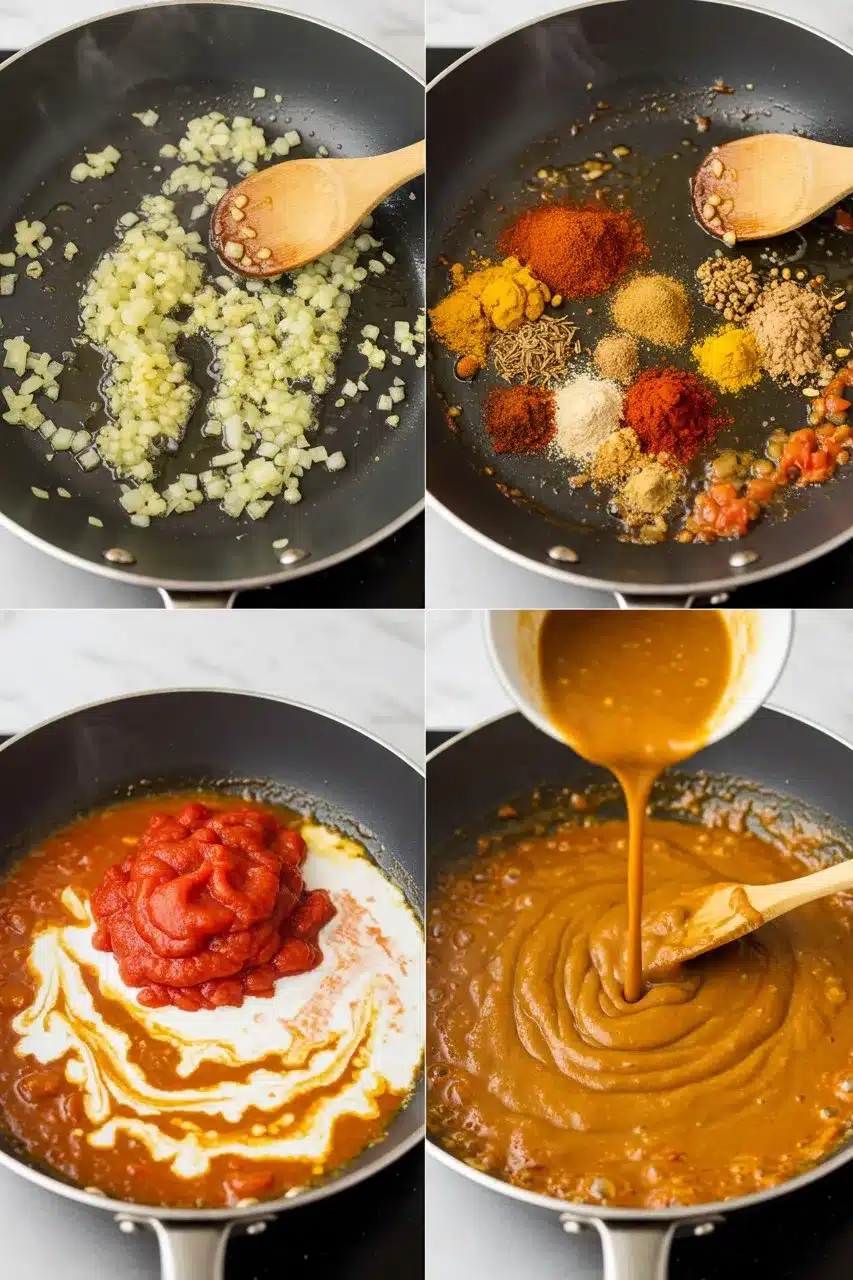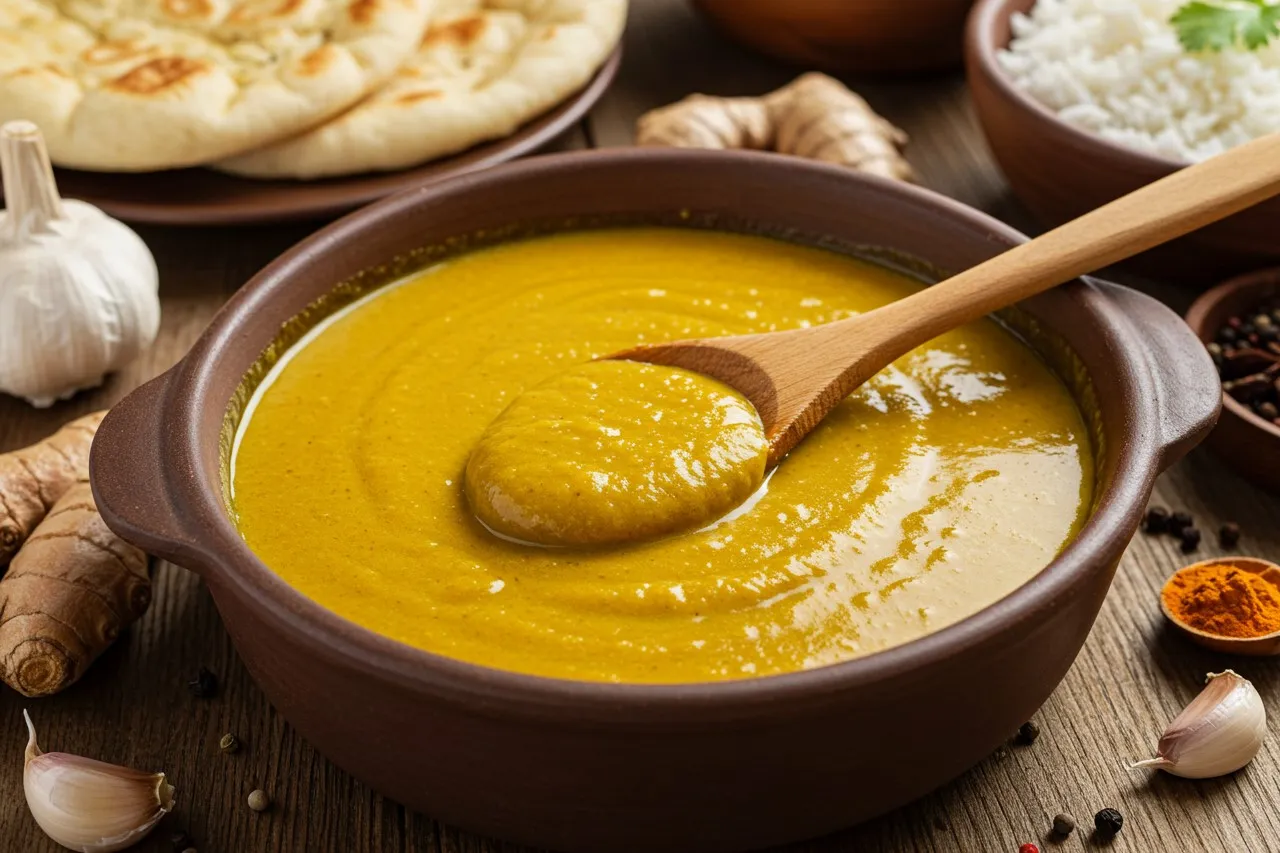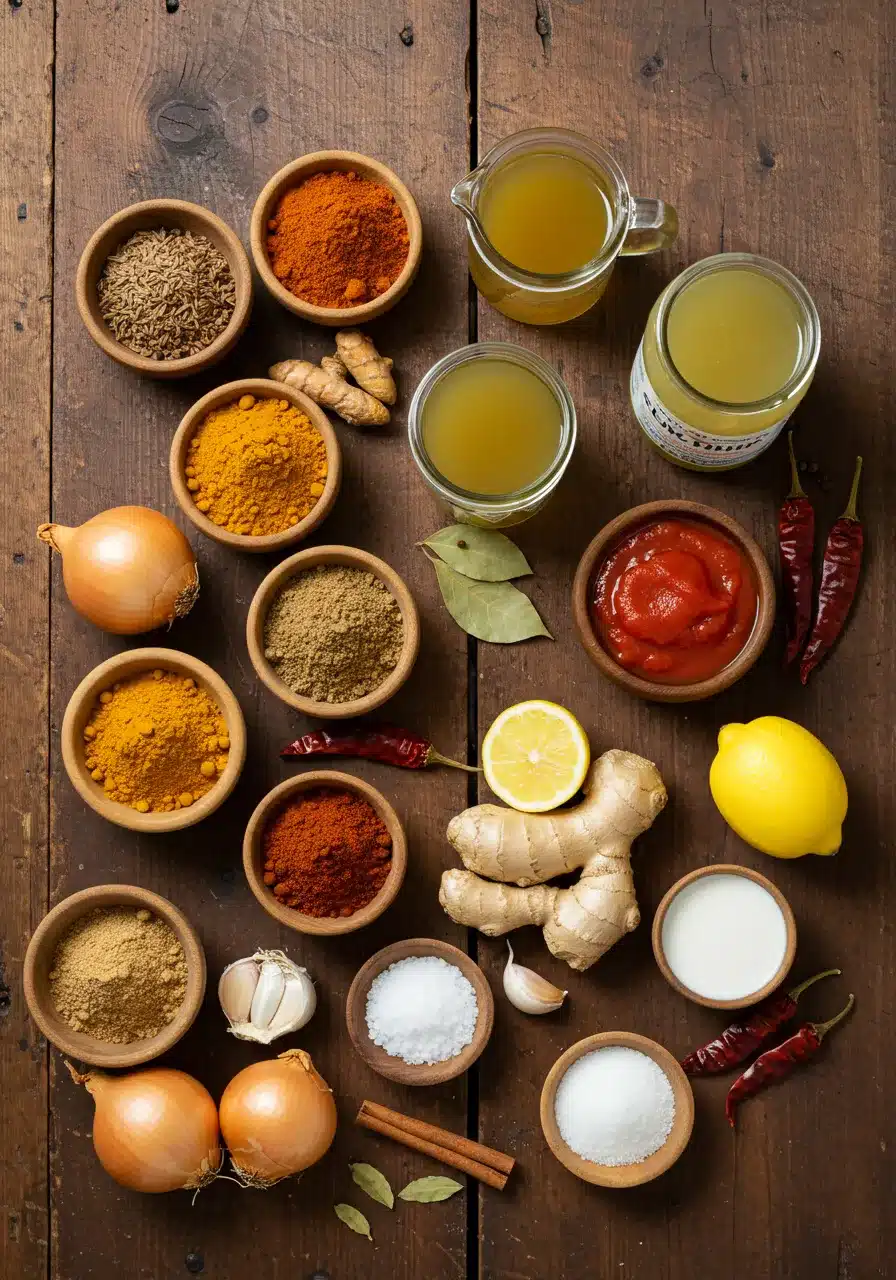A rich, flavorful curry sauce can elevate any dish, adding depth and warmth to every bite. Whether you prefer a creamy coconut base or a bold tomato-infused version, making homemade curry sauce is easier than you think. By using the right blend of spices, aromatics, and fresh ingredients, you can create a sauce that’s far superior to store-bought options.
This guide will walk you through the secrets of crafting the perfect curry sauce—one that’s versatile, customizable, and packed with authentic flavor. With simple techniques and a few essential ingredients, you’ll be able to transform your everyday meals into restaurant-quality dishes. Get ready to master the art of homemade curry sauce with ease.
Print
Homemade Curry Sauce
- Total Time: 30 minutes
- Yield: 4 servings
- Diet: Gluten Free
Description
This homemade curry sauce is rich, aromatic, and packed with deep, authentic flavors. Made with a blend of toasted spices, fresh aromatics, and creamy coconut milk, it creates a smooth and velvety texture perfect for pairing with rice, naan, meats, seafood, or vegetables. This versatile sauce is easy to customize and can be stored for later use, making it a must-have for home-cooked meals.
Ingredients
Aromatics
- 1 tablespoon oil (vegetable or coconut)
- 1 large onion, finely chopped
- 3 cloves garlic, minced
- 1 tablespoon fresh ginger, grated
Spices
- 1 teaspoon turmeric
- 1 teaspoon cumin
- 1 teaspoon coriander
- 1 teaspoon garam masala
- 1 teaspoon paprika or chili powder (adjust for spice level)
Liquids & Base Ingredients
- 1 cup tomato puree
- 1 cup coconut milk (or heavy cream for a richer sauce)
- ½ cup vegetable or chicken broth
Seasoning & Enhancers
- 1 teaspoon salt (adjust to taste)
- ½ teaspoon sugar (optional, for balance)
- 1 tablespoon lemon juice or vinegar
Instructions
Sauté the Aromatics
- Heat oil in a pan over medium heat.
- Add chopped onions and sauté until golden brown.
- Stir in garlic and ginger, cooking for about a minute until fragrant.
Toast the Spices
- Sprinkle in turmeric, cumin, coriander, garam masala, and paprika.
- Stir continuously for 30 seconds to release their flavors.
Build the Base
- Pour in the tomato puree and cook for 5 minutes, stirring occasionally.
- Add coconut milk and broth, mixing until smooth.
Simmer and Adjust
- Reduce the heat and let the sauce simmer for 10–15 minutes.
- Stir occasionally and season with salt, sugar, and lemon juice for balance.
Blend for Smoothness (Optional)
- For a silky texture, blend the sauce until smooth.
Serve or Store
- Use immediately or let cool before storing in an airtight container.
Notes
- For a spicier sauce, increase the chili powder or add fresh chilies.
- For a creamier texture, use heavy cream instead of coconut milk.
- Storage: Refrigerate for up to 4 days or freeze for up to 3 months.
- Prep Time: 10 minutes
- Cook Time: 20 minutes
- Category: Sauce
- Method: Sautéed & Simmered
- Cuisine: Indian, Thai, British
Key Ingredients for Homemade Curry Sauce
A great homemade curry sauce starts with the right ingredients. Each component plays a crucial role in building deep, rich flavors. Here’s what you’ll need:
1. Aromatics for Depth
- Onions – The base for sweetness and texture.
- Garlic and Ginger – Essential for warmth and fragrance.
2. Spices for Authentic Flavor
- Turmeric – Adds color and earthy notes.
- Cumin and Coriander – Provide warmth and nuttiness.
- Garam Masala – A blend that enhances depth.
- Paprika or Chili Powder – Adjust for spice levels.
3. Liquids for Texture
- Coconut Milk – For a creamy, mild sauce.
- Tomato Puree – Adds tang and richness.
- Vegetable or Chicken Broth – Enhances consistency.
4. Enhancers for Balance
- Lemon Juice or Vinegar – Brightens flavors.
- Salt and Sugar – Balance spice and acidity.
Using fresh, high-quality ingredients ensures your curry sauce is packed with authentic taste. With these elements, you can create a flavorful base that complements any dish.
Step-by-Step Instructions for Homemade Curry Sauce
Making homemade curry sauce is simple and rewarding. Follow these steps to achieve a rich, flavorful sauce that enhances any dish.

1. Sauté the Aromatics
- Warm oil in a pan over medium heat.
- Sauté chopped onions until they turn golden brown.
- Add minced garlic and ginger, stirring for about a minute until aromatic.
2. Toast the Spices
- Sprinkle in turmeric, cumin, coriander, garam masala, and chili powder.
- Stir continuously for 30 seconds to release their flavors.
3. Build the Base
- Pour in tomato puree and cook until the sauce thickens.
- Add coconut milk or broth, stirring to combine.
4. Simmer and Adjust
- Lower the heat and allow the sauce to gently simmer for 10–15 minutes.
- Stir occasionally to ensure a smooth consistency.
- Season with salt, sugar, and lemon juice to balance flavors.
5. Blend for Smoothness (Optional)
- For an ultra-smooth texture, puree the sauce until velvety.
Your curry sauce is now ready to enjoy—serve it fresh or store it for later.
Storage and Safety for Homemade Curry Sauce
Proper storage is essential to maintain the freshness and flavor of your homemade curry sauce. Follow these tips to keep it safe and delicious for longer.
1. Refrigerating Curry Sauce
- Let the sauce cool fully before storing.
- Pour it into an airtight container and keep it refrigerated for up to four days.
- Reheat gently on the stove, adding a splash of water or broth if needed.
For more food storage guidelines, visit FoodSafety.gov.
2. Freezing for Longer Storage
- Transfer the sauce into ice cube trays or freezer-safe containers for easy storage.
- Store for up to 3 months without losing flavor.
- When reheating, warm it gently on the stove, adding a bit of water or broth if needed.
Learn more about freezing techniques at USDA Food Safety.
3. Signs of Spoilage
- Sour smell or off-putting odor.
- Change in color or texture.
- Mold or bubbles indicating fermentation.
Always check before consuming. For food safety tips, visit Mayo Clinic.
What to Serve with Homemade Curry Sauce
A well-made curry sauce is incredibly versatile and pairs beautifully with a variety of dishes. Whether you’re looking for a comforting meal or a bold, flavorful dish, here are some of the best ways to enjoy it.

1. Classic Pairings
- Rice – Serve with basmati, jasmine, or brown rice to absorb the rich flavors.
- Naan or Roti – Soft, warm flatbreads are perfect for scooping up the sauce.
- Vegetables – Roast or steam cauliflower, bell peppers, or potatoes for a hearty meal.
2. Protein Options
- Chicken – Simmer grilled or shredded chicken in the sauce for a restaurant-style curry.
- Shrimp – Adds a delicate sweetness that complements spicy sauces.
- Tofu or Chickpeas – Great vegetarian alternatives that soak up flavor beautifully.
3. Creative Uses
- Drizzle over roasted vegetables for extra depth.
- Use as a dipping sauce for grilled meats or bread.
- Mix into pasta or noodles for a fusion-style twist.
Experiment with different combinations to find your favorite way to enjoy homemade curry sauce.
Top Tips for Perfecting Homemade Curry Sauce
Crafting the perfect homemade curry sauce comes down to technique, balance, and quality ingredients. These expert tips will help you achieve a flavorful, restaurant-quality sauce every time.
1. Build Flavor with Slow Cooking
- Sauté onions, garlic, and ginger until caramelized for deeper flavor.
- Toast spices for at least 30 seconds before adding liquids to enhance their aroma.
2. Adjust for the Right Consistency
- For a thicker sauce, simmer longer or add a spoonful of blended cashews.
- If too thick, thin it out with broth, coconut milk, or water in small amounts.
3. Balance Sweetness, Acidity, and Spice
- Enhance the flavors with a splash of lemon juice or a touch of vinegar for added brightness.
- A touch of honey or sugar balances acidity from tomatoes.
- Control heat by adjusting chili powder, cayenne, or fresh chilies to taste.
4. Let It Rest for Enhanced Taste
- Allow the sauce to sit for 10–15 minutes before serving to meld flavors.
- For even better results, refrigerate overnight and reheat the next day.
Master these techniques, and your curry sauce will always turn out rich, balanced, and packed with authentic flavor.
Conclusion
Mastering homemade curry sauce is a game-changer for any kitchen. With the right blend of spices, aromatics, and fresh ingredients, you can create a versatile, flavorful sauce that enhances countless dishes. Whether you prefer a creamy coconut-based curry or a bold tomato-infused version, adjusting the spice levels, consistency, and seasoning allows you to customize the sauce to your taste.
Homemade sauces like this not only provide better flavor than store-bought versions but also allow for complete control over ingredients. Whether you’re drizzling it over rice, meats, or roasted vegetables, this sauce will elevate your meals effortlessly.
For more comforting and hearty recipes, check out Porcupine Soup, a unique dish that pairs beautifully with a warm, spiced sauce. You may also enjoy reading about Taipei Cuisine Quincy Beef Noodle Soup or exploring different sauce ideas like Langostino Sauce. Looking for a healthy start to your day? Try this Gluten-Free dairy-free Breakfast for a delicious, nutritious meal.
With these tips and recipes, your kitchen will be filled with bold, satisfying flavors every time you cook.
FAQs
1. Can I Make Curry Sauce Ahead of Time?
Yes. Homemade curry sauce can be made in advance and stored in the refrigerator for up to 4 days. To extend its shelf life, store it in airtight containers and freeze for up to three months.
2. How Can I Make My Curry Sauce Thicker?
To thicken your sauce, simmer it longer to reduce liquid. You can also blend in cashew paste, coconut cream, or cornstarch slurry for a richer texture.
3. What’s the Best Substitute for Coconut Milk?
If you prefer a dairy-free alternative, use almond milk or cashew cream. For a creamier texture, try Greek yogurt or heavy cream.
4. How Do I Adjust the Spice Level?
For a milder curry sauce, reduce chili powder or cayenne. If you like more heat, add fresh chilies or extra spices like paprika.
5. Can I Use This Sauce for Different Cuisines?
Absolutely. Adjust the spices and base ingredients to match Indian, Thai, or British curry styles for a unique twist.


